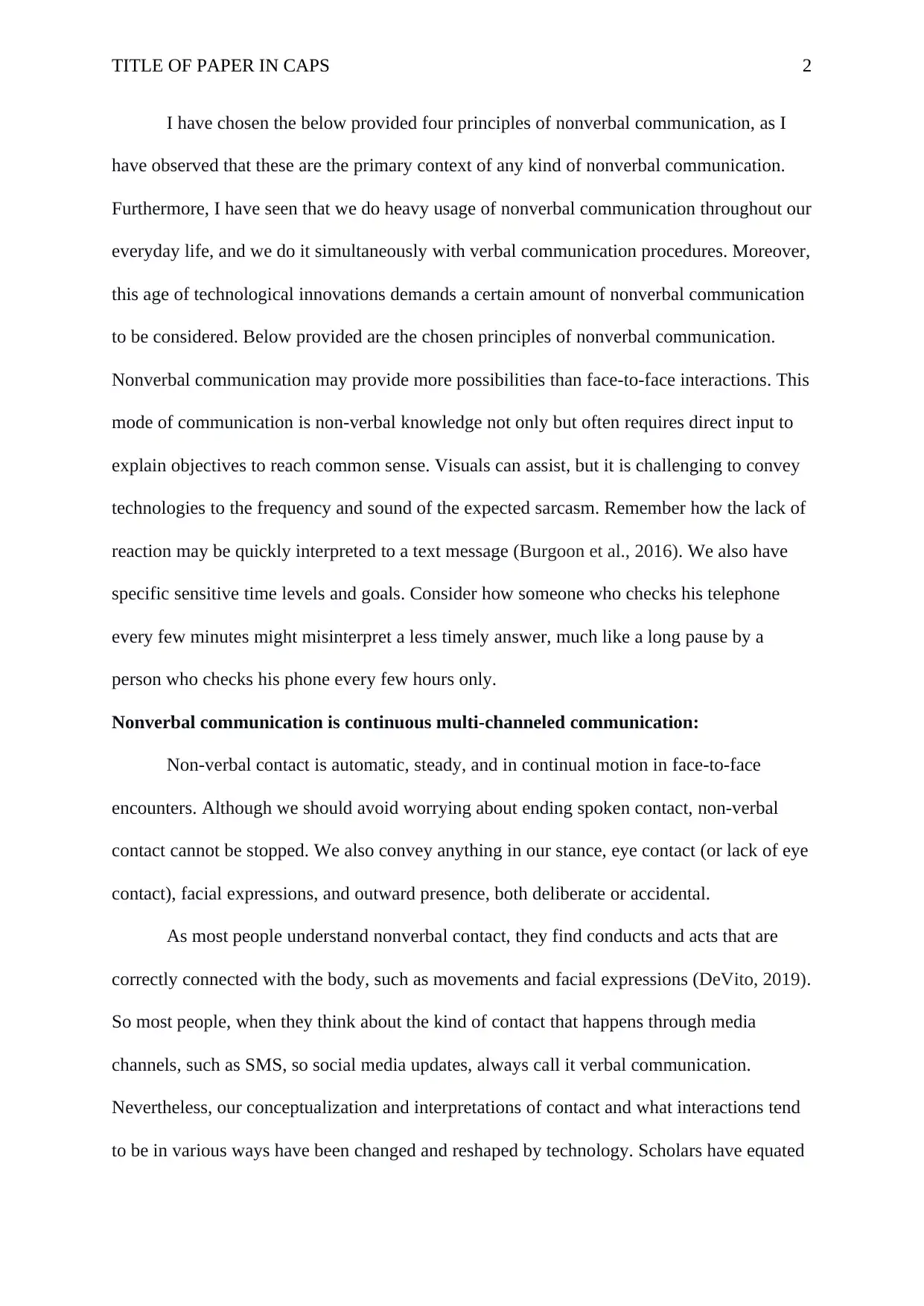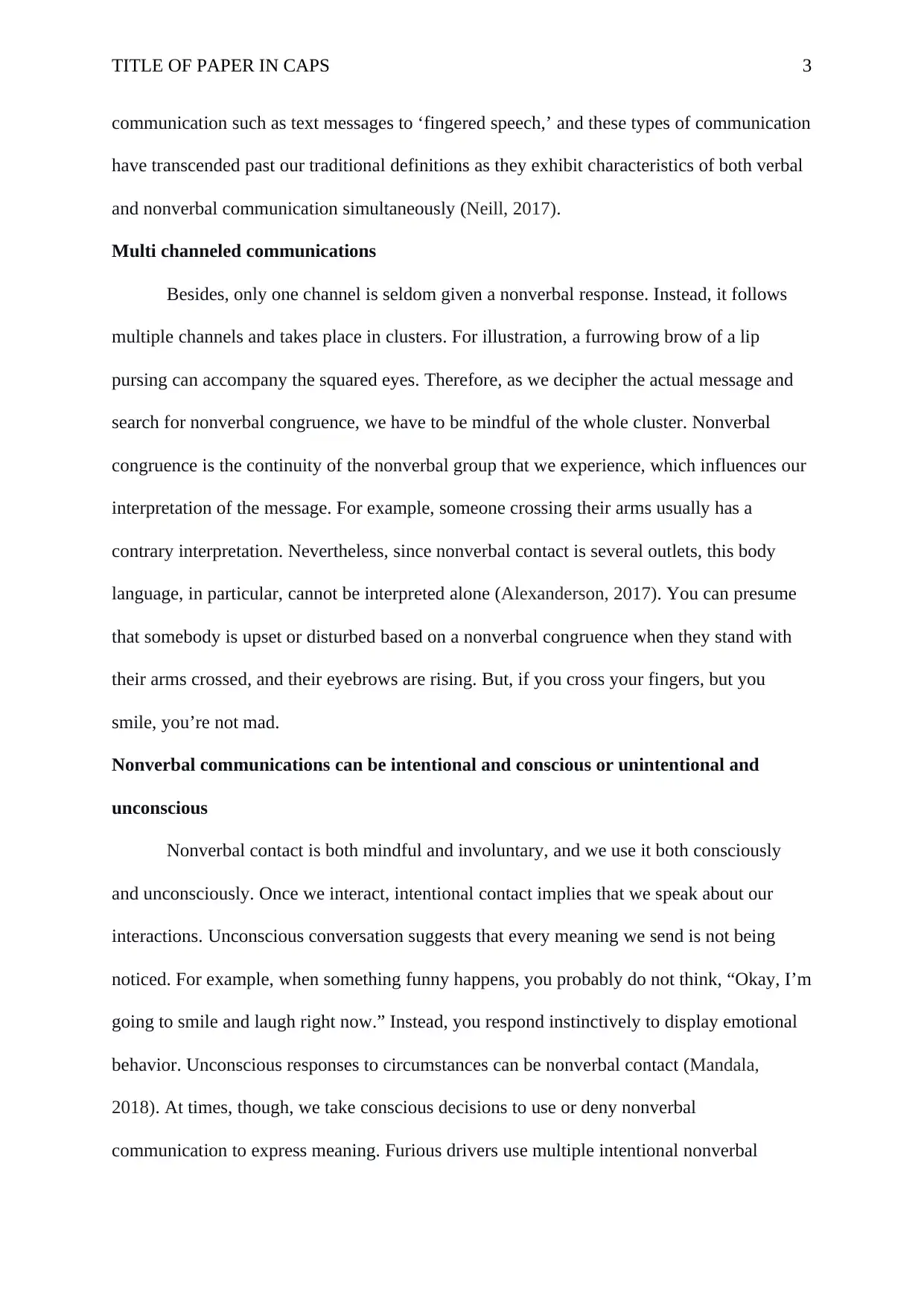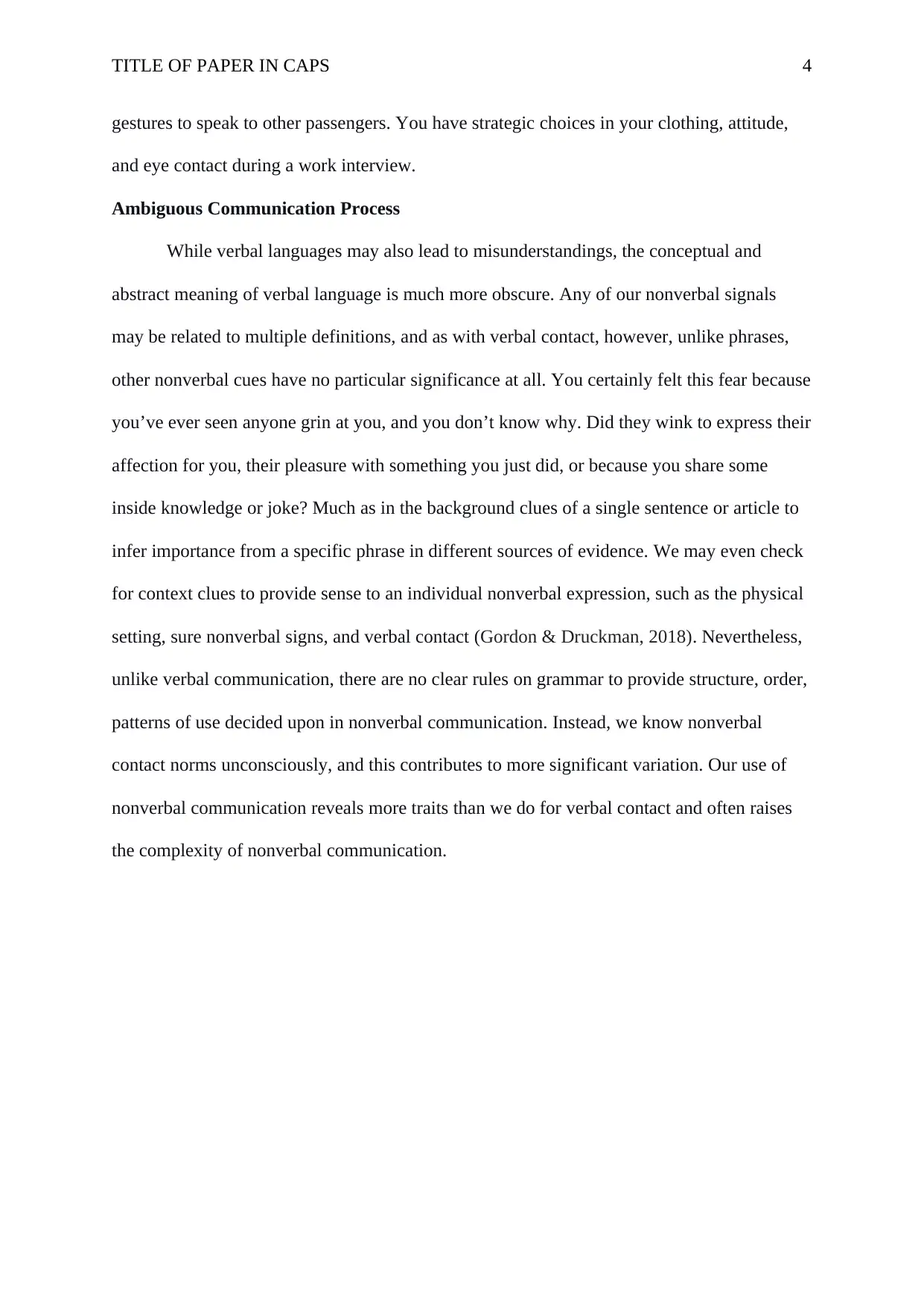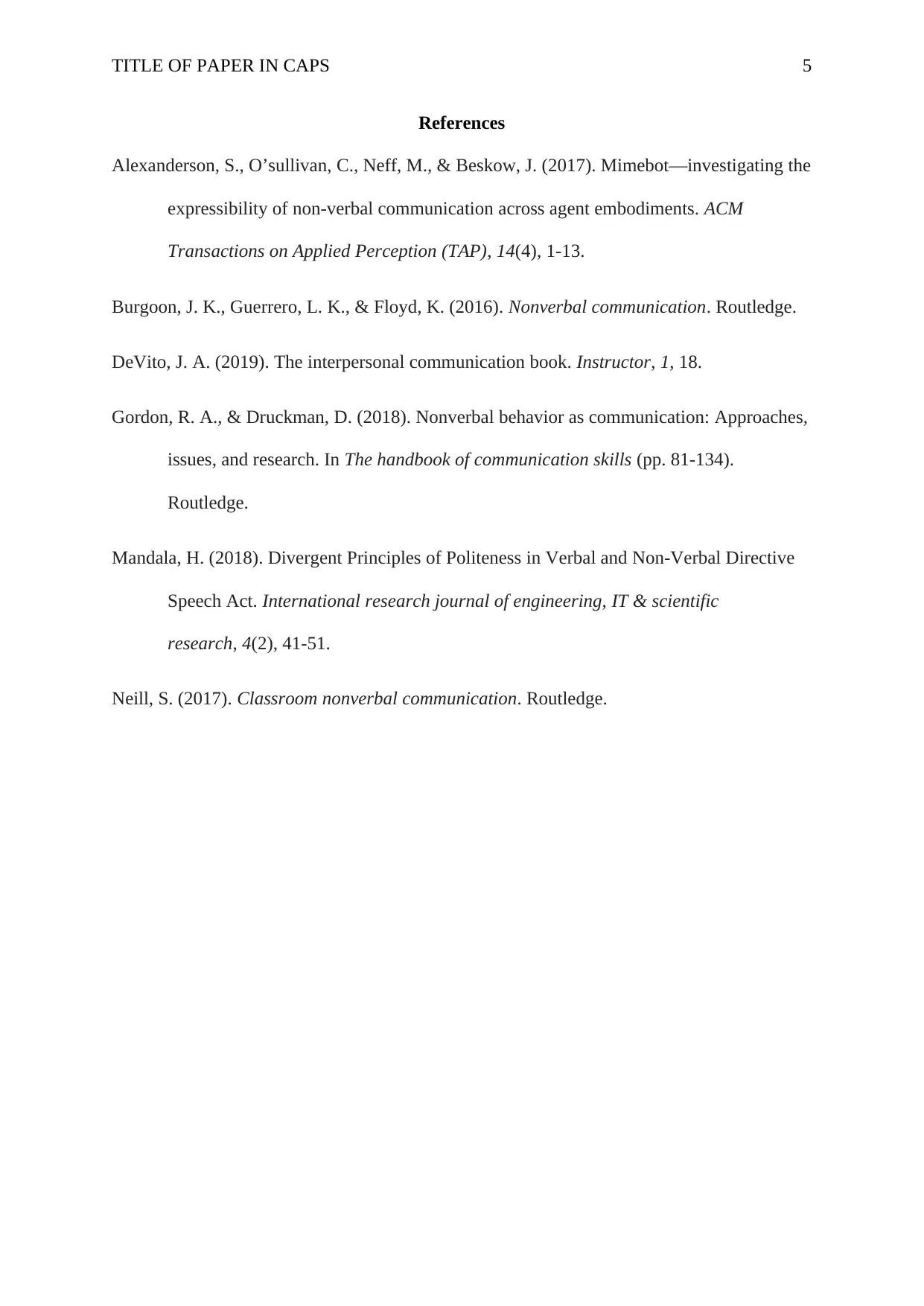In-Depth Analysis of the Core Principles of Nonverbal Communication
VerifiedAdded on 2022/09/12
|5
|1184
|27
Homework Assignment
AI Summary
This paper delves into the four key principles of nonverbal communication: nonverbal communication providing more possibilities than face-to-face interactions, nonverbal communication being continuous and multi-channeled, nonverbal communications being intentional or unintentional, and the ambiguous nature of nonverbal communication. The author emphasizes the significance of these principles in modern communication, especially in the context of technological advancements. The paper discusses how nonverbal cues, such as body language, facial expressions, and eye contact, play a crucial role in conveying messages and how these cues can be both consciously and unconsciously employed. Furthermore, it highlights the importance of understanding the contextual nuances of nonverbal signals to avoid misinterpretations and examines the challenges posed by the ambiguity inherent in nonverbal communication. The paper also references several academic sources to support its claims, providing a comprehensive analysis of the selected principles.

Running head: TITLE OF PAPER IN CAPS 1
Paper Title Capitalized and Centered
Name of Student
Institution Affiliation
Paper Title Capitalized and Centered
Name of Student
Institution Affiliation
Paraphrase This Document
Need a fresh take? Get an instant paraphrase of this document with our AI Paraphraser

TITLE OF PAPER IN CAPS 2
I have chosen the below provided four principles of nonverbal communication, as I
have observed that these are the primary context of any kind of nonverbal communication.
Furthermore, I have seen that we do heavy usage of nonverbal communication throughout our
everyday life, and we do it simultaneously with verbal communication procedures. Moreover,
this age of technological innovations demands a certain amount of nonverbal communication
to be considered. Below provided are the chosen principles of nonverbal communication.
Nonverbal communication may provide more possibilities than face-to-face interactions. This
mode of communication is non-verbal knowledge not only but often requires direct input to
explain objectives to reach common sense. Visuals can assist, but it is challenging to convey
technologies to the frequency and sound of the expected sarcasm. Remember how the lack of
reaction may be quickly interpreted to a text message (Burgoon et al., 2016). We also have
specific sensitive time levels and goals. Consider how someone who checks his telephone
every few minutes might misinterpret a less timely answer, much like a long pause by a
person who checks his phone every few hours only.
Nonverbal communication is continuous multi-channeled communication:
Non-verbal contact is automatic, steady, and in continual motion in face-to-face
encounters. Although we should avoid worrying about ending spoken contact, non-verbal
contact cannot be stopped. We also convey anything in our stance, eye contact (or lack of eye
contact), facial expressions, and outward presence, both deliberate or accidental.
As most people understand nonverbal contact, they find conducts and acts that are
correctly connected with the body, such as movements and facial expressions (DeVito, 2019).
So most people, when they think about the kind of contact that happens through media
channels, such as SMS, so social media updates, always call it verbal communication.
Nevertheless, our conceptualization and interpretations of contact and what interactions tend
to be in various ways have been changed and reshaped by technology. Scholars have equated
I have chosen the below provided four principles of nonverbal communication, as I
have observed that these are the primary context of any kind of nonverbal communication.
Furthermore, I have seen that we do heavy usage of nonverbal communication throughout our
everyday life, and we do it simultaneously with verbal communication procedures. Moreover,
this age of technological innovations demands a certain amount of nonverbal communication
to be considered. Below provided are the chosen principles of nonverbal communication.
Nonverbal communication may provide more possibilities than face-to-face interactions. This
mode of communication is non-verbal knowledge not only but often requires direct input to
explain objectives to reach common sense. Visuals can assist, but it is challenging to convey
technologies to the frequency and sound of the expected sarcasm. Remember how the lack of
reaction may be quickly interpreted to a text message (Burgoon et al., 2016). We also have
specific sensitive time levels and goals. Consider how someone who checks his telephone
every few minutes might misinterpret a less timely answer, much like a long pause by a
person who checks his phone every few hours only.
Nonverbal communication is continuous multi-channeled communication:
Non-verbal contact is automatic, steady, and in continual motion in face-to-face
encounters. Although we should avoid worrying about ending spoken contact, non-verbal
contact cannot be stopped. We also convey anything in our stance, eye contact (or lack of eye
contact), facial expressions, and outward presence, both deliberate or accidental.
As most people understand nonverbal contact, they find conducts and acts that are
correctly connected with the body, such as movements and facial expressions (DeVito, 2019).
So most people, when they think about the kind of contact that happens through media
channels, such as SMS, so social media updates, always call it verbal communication.
Nevertheless, our conceptualization and interpretations of contact and what interactions tend
to be in various ways have been changed and reshaped by technology. Scholars have equated

TITLE OF PAPER IN CAPS 3
communication such as text messages to ‘fingered speech,’ and these types of communication
have transcended past our traditional definitions as they exhibit characteristics of both verbal
and nonverbal communication simultaneously (Neill, 2017).
Multi channeled communications
Besides, only one channel is seldom given a nonverbal response. Instead, it follows
multiple channels and takes place in clusters. For illustration, a furrowing brow of a lip
pursing can accompany the squared eyes. Therefore, as we decipher the actual message and
search for nonverbal congruence, we have to be mindful of the whole cluster. Nonverbal
congruence is the continuity of the nonverbal group that we experience, which influences our
interpretation of the message. For example, someone crossing their arms usually has a
contrary interpretation. Nevertheless, since nonverbal contact is several outlets, this body
language, in particular, cannot be interpreted alone (Alexanderson, 2017). You can presume
that somebody is upset or disturbed based on a nonverbal congruence when they stand with
their arms crossed, and their eyebrows are rising. But, if you cross your fingers, but you
smile, you’re not mad.
Nonverbal communications can be intentional and conscious or unintentional and
unconscious
Nonverbal contact is both mindful and involuntary, and we use it both consciously
and unconsciously. Once we interact, intentional contact implies that we speak about our
interactions. Unconscious conversation suggests that every meaning we send is not being
noticed. For example, when something funny happens, you probably do not think, “Okay, I’m
going to smile and laugh right now.” Instead, you respond instinctively to display emotional
behavior. Unconscious responses to circumstances can be nonverbal contact (Mandala,
2018). At times, though, we take conscious decisions to use or deny nonverbal
communication to express meaning. Furious drivers use multiple intentional nonverbal
communication such as text messages to ‘fingered speech,’ and these types of communication
have transcended past our traditional definitions as they exhibit characteristics of both verbal
and nonverbal communication simultaneously (Neill, 2017).
Multi channeled communications
Besides, only one channel is seldom given a nonverbal response. Instead, it follows
multiple channels and takes place in clusters. For illustration, a furrowing brow of a lip
pursing can accompany the squared eyes. Therefore, as we decipher the actual message and
search for nonverbal congruence, we have to be mindful of the whole cluster. Nonverbal
congruence is the continuity of the nonverbal group that we experience, which influences our
interpretation of the message. For example, someone crossing their arms usually has a
contrary interpretation. Nevertheless, since nonverbal contact is several outlets, this body
language, in particular, cannot be interpreted alone (Alexanderson, 2017). You can presume
that somebody is upset or disturbed based on a nonverbal congruence when they stand with
their arms crossed, and their eyebrows are rising. But, if you cross your fingers, but you
smile, you’re not mad.
Nonverbal communications can be intentional and conscious or unintentional and
unconscious
Nonverbal contact is both mindful and involuntary, and we use it both consciously
and unconsciously. Once we interact, intentional contact implies that we speak about our
interactions. Unconscious conversation suggests that every meaning we send is not being
noticed. For example, when something funny happens, you probably do not think, “Okay, I’m
going to smile and laugh right now.” Instead, you respond instinctively to display emotional
behavior. Unconscious responses to circumstances can be nonverbal contact (Mandala,
2018). At times, though, we take conscious decisions to use or deny nonverbal
communication to express meaning. Furious drivers use multiple intentional nonverbal
⊘ This is a preview!⊘
Do you want full access?
Subscribe today to unlock all pages.

Trusted by 1+ million students worldwide

TITLE OF PAPER IN CAPS 4
gestures to speak to other passengers. You have strategic choices in your clothing, attitude,
and eye contact during a work interview.
Ambiguous Communication Process
While verbal languages may also lead to misunderstandings, the conceptual and
abstract meaning of verbal language is much more obscure. Any of our nonverbal signals
may be related to multiple definitions, and as with verbal contact, however, unlike phrases,
other nonverbal cues have no particular significance at all. You certainly felt this fear because
you’ve ever seen anyone grin at you, and you don’t know why. Did they wink to express their
affection for you, their pleasure with something you just did, or because you share some
inside knowledge or joke? Much as in the background clues of a single sentence or article to
infer importance from a specific phrase in different sources of evidence. We may even check
for context clues to provide sense to an individual nonverbal expression, such as the physical
setting, sure nonverbal signs, and verbal contact (Gordon & Druckman, 2018). Nevertheless,
unlike verbal communication, there are no clear rules on grammar to provide structure, order,
patterns of use decided upon in nonverbal communication. Instead, we know nonverbal
contact norms unconsciously, and this contributes to more significant variation. Our use of
nonverbal communication reveals more traits than we do for verbal contact and often raises
the complexity of nonverbal communication.
gestures to speak to other passengers. You have strategic choices in your clothing, attitude,
and eye contact during a work interview.
Ambiguous Communication Process
While verbal languages may also lead to misunderstandings, the conceptual and
abstract meaning of verbal language is much more obscure. Any of our nonverbal signals
may be related to multiple definitions, and as with verbal contact, however, unlike phrases,
other nonverbal cues have no particular significance at all. You certainly felt this fear because
you’ve ever seen anyone grin at you, and you don’t know why. Did they wink to express their
affection for you, their pleasure with something you just did, or because you share some
inside knowledge or joke? Much as in the background clues of a single sentence or article to
infer importance from a specific phrase in different sources of evidence. We may even check
for context clues to provide sense to an individual nonverbal expression, such as the physical
setting, sure nonverbal signs, and verbal contact (Gordon & Druckman, 2018). Nevertheless,
unlike verbal communication, there are no clear rules on grammar to provide structure, order,
patterns of use decided upon in nonverbal communication. Instead, we know nonverbal
contact norms unconsciously, and this contributes to more significant variation. Our use of
nonverbal communication reveals more traits than we do for verbal contact and often raises
the complexity of nonverbal communication.
Paraphrase This Document
Need a fresh take? Get an instant paraphrase of this document with our AI Paraphraser

TITLE OF PAPER IN CAPS 5
References
Alexanderson, S., O’sullivan, C., Neff, M., & Beskow, J. (2017). Mimebot—investigating the
expressibility of non-verbal communication across agent embodiments. ACM
Transactions on Applied Perception (TAP), 14(4), 1-13.
Burgoon, J. K., Guerrero, L. K., & Floyd, K. (2016). Nonverbal communication. Routledge.
DeVito, J. A. (2019). The interpersonal communication book. Instructor, 1, 18.
Gordon, R. A., & Druckman, D. (2018). Nonverbal behavior as communication: Approaches,
issues, and research. In The handbook of communication skills (pp. 81-134).
Routledge.
Mandala, H. (2018). Divergent Principles of Politeness in Verbal and Non-Verbal Directive
Speech Act. International research journal of engineering, IT & scientific
research, 4(2), 41-51.
Neill, S. (2017). Classroom nonverbal communication. Routledge.
References
Alexanderson, S., O’sullivan, C., Neff, M., & Beskow, J. (2017). Mimebot—investigating the
expressibility of non-verbal communication across agent embodiments. ACM
Transactions on Applied Perception (TAP), 14(4), 1-13.
Burgoon, J. K., Guerrero, L. K., & Floyd, K. (2016). Nonverbal communication. Routledge.
DeVito, J. A. (2019). The interpersonal communication book. Instructor, 1, 18.
Gordon, R. A., & Druckman, D. (2018). Nonverbal behavior as communication: Approaches,
issues, and research. In The handbook of communication skills (pp. 81-134).
Routledge.
Mandala, H. (2018). Divergent Principles of Politeness in Verbal and Non-Verbal Directive
Speech Act. International research journal of engineering, IT & scientific
research, 4(2), 41-51.
Neill, S. (2017). Classroom nonverbal communication. Routledge.
1 out of 5
Related Documents
Your All-in-One AI-Powered Toolkit for Academic Success.
+13062052269
info@desklib.com
Available 24*7 on WhatsApp / Email
![[object Object]](/_next/static/media/star-bottom.7253800d.svg)
Unlock your academic potential
Copyright © 2020–2025 A2Z Services. All Rights Reserved. Developed and managed by ZUCOL.




